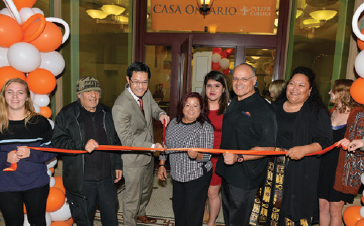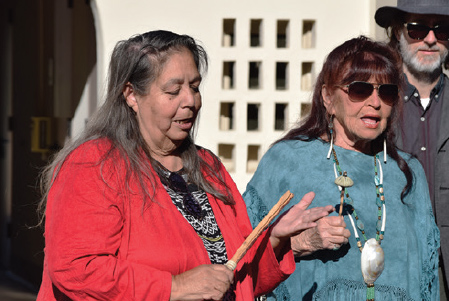
This article first appeared in Pitzer College’s alumni magazine, The Participant. Read the full fall/winter edition online.
Jenessa Flores Parker ’10 knows that not every
child’s early exposure to education is positive. She also realizes how much
this matters. As an urban fellow for Pitzer College’s Community Engagement
Center (CEC), she spoke with young men at Camp Afflerbaugh-Paige, a Los Angeles
County juvenile detention center and CEC partner organization. Many had
disliked their school experience from the start.
Now Flores Parker is the Pitzer College site
director for Jumpstart, a national nonprofit organization and CEC community
partner that prepares young children from low-income neighborhoods for academic
success. She and Pitzer students team with Jumpstart sites at local Easter
Seals Child Development Centers to create a positive learning environment for
preschoolers. The experience has made a bigger impact on Flores Parker than any
other, and she is certain the Pitzer students feel the same.
“Working with the children makes Pitzer students
realize the world is unfair but that there are things they can change. Some end
up becoming teachers or working on policy change. A lot have become Fulbright
scholars. They grow into leaders,” explains Flores Parker. “It all comes back
to their experience at Jumpstart and seeing the big picture. They realize the
difference between equality and equity. And at the end of the year, there are
always tears— not from the children, but from the college students. The
children are in their hearts and stay there forever.”
Producing positive change through community
collaborations has always been the motivating force behind the CEC, from its
founding 20 years ago by faculty members Alan Jones and Lourdes Arguelles to
today under the leadership of Associate Professor of Urban Studies and
Assistant Vice President of Community Engagement Tessa Hicks Peterson.
The CEC originated with a desire to improve how
Pitzer students engaged the community. Jones recalls: “The College had
volunteer opportunities to work with the community, but the way these related
to the curriculum wasn’t clear. We had the idea that students would take
courses in nearby Ontario and do an internship with a municipal agency or
nonprofit organization to learn how cities work. Then we would talk about how
various factions in a city might function better together.”
That idea became the Pitzer in Ontario program,
with Jones as director. But he and Arguelles saw a need for something more.
“One of the limitations was that students would be
there for a semester and leave,” explains Jones. “We wanted to come up with a
model where you didn’t have jarring arrivals and departures in the middle of
ongoing projects.”
The result, in 1998, was the Center for California
Cultural and Social Issues (CCCSI), which later became the CEC. Designed in
consultation with community partners, the CCCSI incorporated five-year plans
and provided a framework for the program’s evolution.
“The student faces might change, but what was expected of us was
laid out. It was good for our partners because nonprofits operating on a
shoestring rarely get to do strategic planning,” says Jones, who became the
CCCSI director.
Most important, the relationship between the College and its
community partners was based on mutual respect and input. Jones explains: “In
the charity model, the community is a pocket of need, and you are the
salvation. That’s problematic. Our jumping off point was that we were members
of a community, and we embedded community engagement in the academic program. I
didn’t know of anyone else doing that at the time.”

20 Years in Ontario
The Pitzer in Ontario (PIO) program, like CEC, is celebrating its 20th anniversary this year. Two decades ago, PIO created a program that immersed students in local social change movements through a set of core courses, critical community studies and research methodology, including a 150-hour practicum with local organizations. Recently renamed CASA Pitzer, the program is now housed in a historic building in the heart of downtown Ontario. At CASA Pitzer, local nonprofit agencies share space with students to create a hub for academic programs, community action and social advocacy.
Pitzer was ideally suited to this approach to community
engagement: Social responsibility, student engagement and intercultural
understanding are among its core values. With this mindset, viewing community
organizations as collaborators and co-educators came naturally.
Since then, courses in the theory and practice of social
responsibility and social justice have become a student graduation requirement.
The College also made community engagement recognized in faculty promotion and
tenure decisions.
Community engagement staffing increased when urban fellow
positions were created to enable Pitzer students to work full-time at partner
sites after graduation. It also changed, with Jones transitioning from CCCSI
director to dean of faculty.
“I became a champion of our interdisciplinary, community approach
to engagement, the idea that you could do meaningful pedagogy,” says Jones, who
served as dean until 2012. “I think we had a number of faculty come to Pitzer
because this was precisely what they wanted to do.”
Today’s CEC is still part of Pitzer’s academic enterprise. This
helps in fulfilling the CEC’s mission to support faculty, students, staff and
partner organizations advancing social responsibility and community engagement
through research, service, advocacy and action.
“With our office situated in academic affairs, we’re better able
to leverage resources and our impact,” says Tricia Morgan ’08, who joined CEC
in 2008 is now managing director. “We’re here to connect people and bring
theory to practice.”
Professor of Psychology Mita Banerjee connected theory to
practice when she created opportunities for students in her Child Development
course to work with at-risk children through Prototypes Women’s Center, local
schools and other community organizations.
“From the very beginning, it was clear to me that this
interaction was the magic in the course,” says Banerjee, who is now the interim
chair of Pitzer’s Institute for Global/Local Action & Study and faculty
co-director of CEC. “That face-to-face connection to children, particularly to
at-risk children, really brought the kinds of things we were talking about,
reading about and writing about full circle.”
Morgan adds that Pitzer’s interdisciplinary and
cross-disciplinary approach to education allows the CEC “to facilitate
community-based research that supports the needs of communities.”

Native Initiatives
During her first year as an elder-in-residence with Pitzer’s Community Engagement Center, Tongva elder Julia Bogany invited three students to her house to weave reed baskets, share life stories and learn about Tongva culture. This small circle formed around a question central to Bogany’s concept of community: “How do people take care of each other unless they know each other?”
Bogany has now worked with CEC’s Native Initiatives program for a dozen years, creating engagement opportunities for Pitzer students, faculty, staff and local Native American communities. She says these interactions foster mutual learning as well as collective action.
“I tell students all the time, ‘I’m not just the teacher, I’m learning from you, too,’” Bogany says. “It’s about learning. It’s also about how we can go hand in hand and show the world that we can change it. Can we work together? That’s what’s important.”
The CEC has worked for many years with core partners Camp
Afflerbaugh-Paige, Prototypes Women’s Center, the Pomona Economic Opportunity
Center for day laborers, Jumpstart and a variety of Native American programs.
The Center also provides funding to support student participation in
community-based projects and for faculty to incorporate community-based
speakers and course materials in their classes. This year CEC also sponsored
the Pitzer–Girls Fly! Global Intergenerational Women’s Leadership Conference,
awarded fellowships and summer internships, and recognized students for their
academic and community engagement.
Hicks Peterson emphasizes that the Center is far from the only
force on campus pushing for social change and service learning. She cites the
many faculty-led community engagement efforts that fall outside CEC’s direct
purview, such as Professor Paul Faulstich’s work with the Leadership in
Environmental Education Partnership, Professor Ethel Jorge’s creation of the
Community-Based Spanish Practicum and Professor Kathleen Yep’s collaboration
with Literacy for All of Monterey Park.
Collectively, all these programs create opportunities for
students to learn about critical issues in “rigorous, intellectually challenging
ways,” Hicks Peterson says.
“The work broadens their understanding of their own identity. It
impacts the careers they choose, their political activism, what they study in
graduate school. The impact is immeasurable. We have countless stories of how
it changes lives.”
The CEC is changing as well. Reflecting on how to build on the
first 20 years, Hicks Peterson and Morgan realized the CEC provided more direct
service than originally envisioned. Meanwhile, assessments revealed faculty and
students could be better equipped for community engagement.
“Our core partnerships created a reliance on our ability to
provide service. But our work aims to go beyond service to collective
changemaking. We’re bridges, allies and engaged participants,” says Hicks
Peterson.
Now CEC is focusing on developing communities of practice,
training students and faculty, and providing online resources. It is shifting
from a model centered on a few core partners to one that incorporates more
academic disciplines and five broad themes: immigration and labor; health and
environment; arts and culture; education and mentoring; and incarceration,
re-entry and recovery.
“It’s a sustainable model that allows us to support more faculty
and more ideas,” explains Hicks Peterson. “The thematic clusters get to the
heart of topics that are important in our communities. Under each cluster,
there will be courses, clubs and organizations that work within that area.
Collectively, we can move the needle on the social issues of our times.”